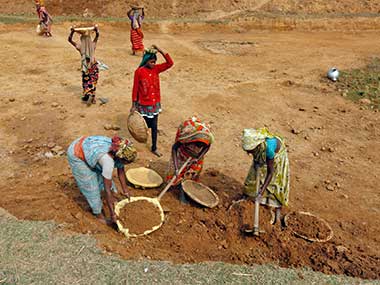New Delhi: In a candid admission, the government said Mahatma Gandhi National Rural Employment Guarantee Scheme (MGNREGS) has not been able to deliver 100 days employment as promised under the flagship rural job programme and has asked the state governments to ensure more durable work for unskilled manual labourers and timely payment. [caption id=“attachment_4294491” align=“alignleft” width=“380”]  Jobs under MGNREGS are getting scarce. Reuters[/caption] The government documents reviewed by Firstpost clearly stated that MGNREGS is not fully demand-driven and guaranteed 100 days employment is not being provided. The documents further said there is considerable delay in material payment directly affecting the progress of works. Most importantly, the Centre has flagged low wage rate in MGNREGS saying that payment made to unskilled labour is not in sync with the market rate resulting in less demand for work under the scheme. There is also the issue of financial misappropriation at the ground level in the states and audit conducted till December last year revealed that more than Rs 130 crore was siphoned off from the scheme. More than 1.33 lakh complaints regarding violation of rules were reported to the Central government which were subsequently forwarded to the states for further action but merely 6,000 issues have been addressed so far and more than 1.27 lakh complaints related to irregularities are still pending with the states. The Centre has asked the states to recover the siphoned off money from those responsible and take appropriate action on complaints related to the violation. Average days employment per household in the hinterland against promised 100 days was merely 39.26 and only 10.34 lakh households could get 100 days employment. The Centre in order to make the scheme more effective is planning to conduct a study on revision of wages to the landless labourers and also working with the states to converge MGNREGS with other welfare scheme focused on rural India. MGNREGS is basically fall back option for the rural households when no better employment opportunity is available, however, the demand for work is influenced by various factors like timely monsoon or availability of more remunerative employment opportunities. The government documents also revealed the lackadaisical approach of the states in the implementation of Pradhan Mantri Awas Yojna (PMAY), which aims to provide housing for all by 2022. The Central government raising key concerns said the socio-economic data used to identify the beneficiaries is not accurate and there is a possibility of exclusion of those who qualify under the scheme. The Centre has also flagged poor quality of houses pointing out the bad flooring and lack of plastering in these accommodations. The Centre vouches for significant improvement in quality and wants the states to also focus on houses that have been left incomplete. The government further said there has been significant improvement in the implementation of the project in states like Uttar Pradesh, Kerala, Madhya Pradesh and Odisha. The time of construction under the scheme in Uttar Pradesh has come down to less than 100 days and more than 13 lakh houses have been constructed so far. Similarly, 13.3 lakh houses have been constructed in Madhya Pradesh and 8 lakh in Odisha. Another important scheme, which came under the scanner, is Saansad Adarsh Gram Yojna in which a Member of Parliament (MP) adopts a village for overall development to make it a model village. The programme has no specific Central funding and money has to be spent from Member of Parliament Local Area Development Scheme (MPLADS) and CSR fundings. The Centre has candidly admitted that there is no significant achievement of this scheme on the ground and even funds from MPLADS is not being provided in all the cases. Since the success of the programme solely depends on the interest taken by concerned MPs, the progress of adopting and developing the village is really slow. From the highest 703 villages which were adopted during the launch of the scheme in 2014, the number has come down to 203 villages in December last year. The government had sent a team to Uttar Pradesh, which visited two villages and noted in the report that it was difficult to call them ‘model village.’ Documents revealed that the government is mulling to redesign the scheme and review the guidelines for better impact.
MGNREGS is basically fall back option for the rural households when no better employment opportunity is available, however, the demand for work is influenced by various factors like timely monsoon or availability of more remunerative employment opportunities.
Advertisement
End of Article


)

)
)
)
)
)
)
)
)



